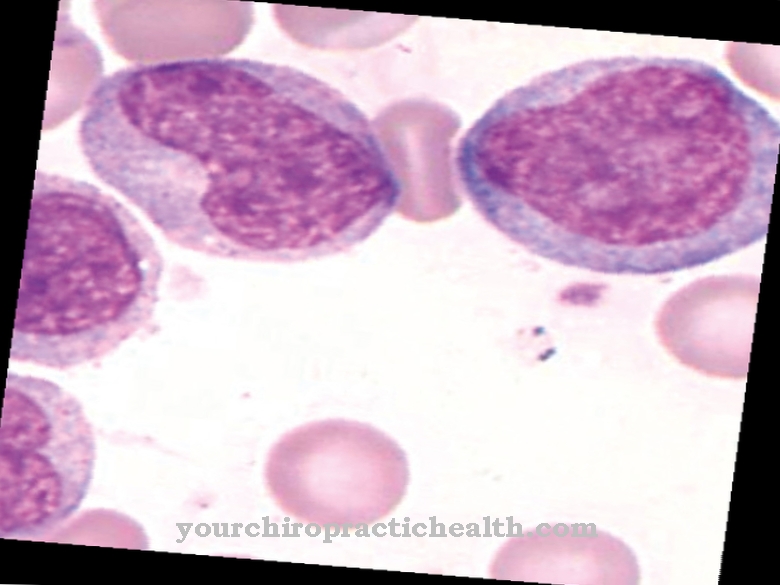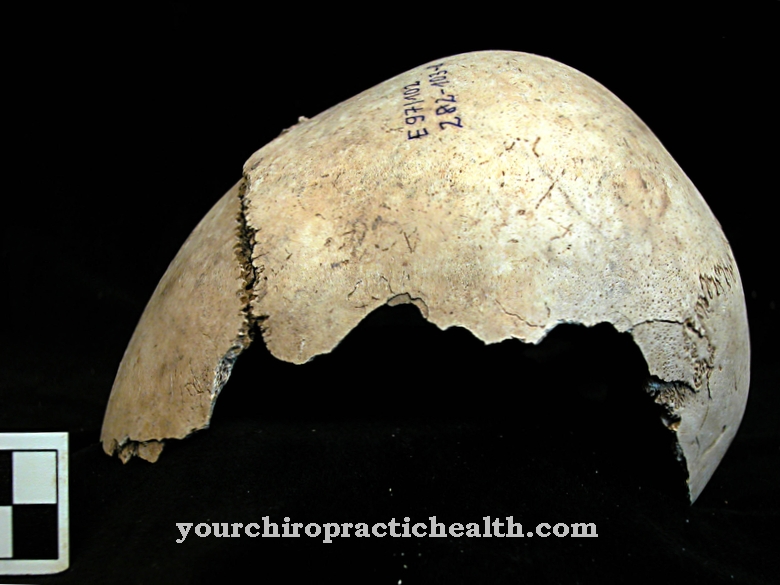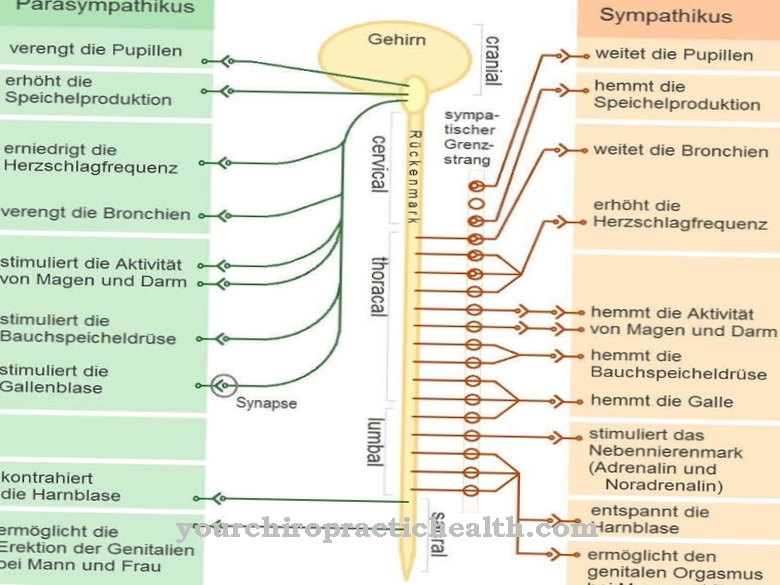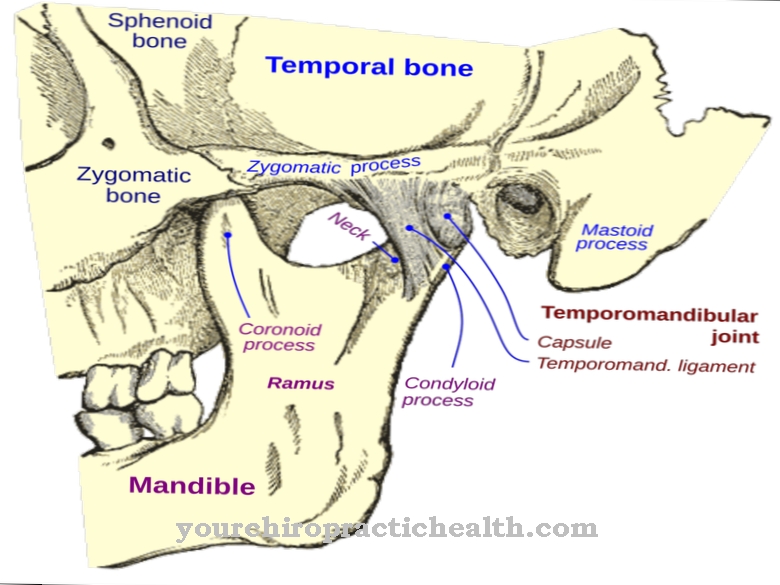The Vaginal artery is also known as Vaginal artery denotes and supplies the woman's vagina with oxygen and nutrients in the blood. In some women, the artery is not created, but is replaced by so-called rami vaginalis. Potential diseases of the vaginal artery are arteriosclerosis and occlusive disease.
What is the vaginal artery?
The vaginal artery is also known as the vaginal artery. The arterial blood vessel is an important artery within the abdominal cavity, which is the main supply vessel for the vagina. In humans, two or three vaginal arteries per side arise from the internal iliac artery.
That distinguishes humans from other living beings. In cloven-hoofed animals, the vaginal artery also originates from the internal iliac artery, but in predators, for example, the origin of the artery corresponds to the internal pudendal artery. In animal anatomy, the prostatic artery is considered to be a homologous form to the vaginal artery in male animals. Not all women have one or more vaginal arteries. In humans, the artery is partially, and sometimes completely, replaced by the vaginal rami. These rami arise from the inferior vesical artery, the internal pudendal artery or the uterine artery.
Anatomy & structure
All of the body's arteries draw their blood directly or indirectly from the central artery, also known as the aorta. The blood vessels typically have a three-layer wall with concentrically arranged layers. Towards the lumen, a layer of endothelial cells lies within the vaginal artery over an underlying layer of connective tissue.
The artery is also equipped with smooth muscles that allow blood flow to be regulated. The muscles are embedded in an additional layer of connective tissue. In most cases, two or three vaginal arteries arise from the internal iliac artery on either side and extend from there into the abdominal cavity. The vaginal artery has a urinary bladder inflow, also known as the caudal vesical artery. In addition, the artery is equipped with an inflow from the rectum: the so-called arteria rectalis media. In some women, the vaginal artery sends a ramus to the uterus called a ramus uterinus.
Function & tasks
The body's arteries form a circuit. Like all arteries, the vaginal artery is one of the blood vessels that carry oxygen- and nutrient-rich blood from the heart. The nutrients in the blood are vital and the oxygen they contain is just as important. Much of the oxygen in the artery is bound to the hemoglobin of the blood and can thus be transported into the abdominal cavity.
Blood takes on the function of a transport medium in the human body. The arteries carry the blood from the heart to the individual tissues and thus keep the tissues and organs of the body alive. The release of oxygen occurs when the pH value changes and enables the nearby tissues to absorb oxygen. The vaginal artery fulfills this task primarily in relation to the vagina and is considered to be the main blood supply for the genital organ. The artery also keeps the heart-generated blood pressure stable inside.
Like all other arteries, the main artery of the vagina branches into smaller and smaller arteries and arterioles. The branches and arterioles of the artery also supply parts of the vaginal vestibule, rectum and urinary bladder with blood and the nutrients it contains, as well as oxygen molecules. The internal iliac artery, the offspring of which is the vaginal artery, also supplies the pelvic wall and the pelvic viscera, the buttocks and the medial thigh with arterial blood.
Diseases
The vaginal artery can be affected by arterial disease just like any other artery in the body. Atherosclerosis is one of the most important arterial diseases. Atherosclerosis usually starts early due to an unhealthy lifestyle. In atherosclerosis, deposits accumulate within the vaginal artery, which make the blood vessel increasingly narrow.
When a patient has atherosclerosis, it is always a disease of the entire body. Thus, if the vaginal artery becomes calcified, not only the blood supply to the vagina, urinary bladder and rectum may be restricted. Symptoms can also occur in relation to the blood supply to the heart, limbs and brain. Arterial occlusive disease, which causes circulatory disorders, is just as widespread. Like arteriosclerosis, this arterial disease is now one of the widespread diseases. Heart attacks and strokes are possible secondary diseases in this regard.
If the vaginal artery is suddenly occluded without warning, it is called acute occlusion. Such an acute blockage can arise, for example, from a blood clot and always corresponds to an absolute emergency that calls for professional treatment immediately. Diseases such as the abdominal aortic aneurysm are somewhat less common. Aneurysms are bulges that manifest themselves in the shape of berries, sacks, tails, or tendrils on the vessel wall of arteries. Aneurysms are accompanied by a widening of the vascular lumen and an irreversible thinning of the vascular wall.
The phenomena represent a potentially life-threatening change in the blood system at every location and accordingly often lead to death in the event of a sudden rupture. The vaginal artery is not very often affected by aneurysms. Basically, the bulges in the vessel wall occur ten times as often in men. The aneurysm is often the long-term consequence of arteriosclerosis.




























